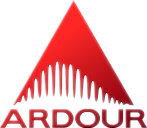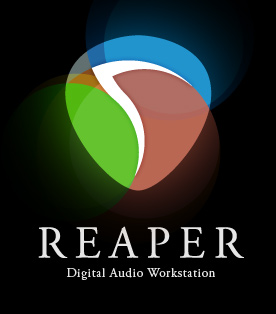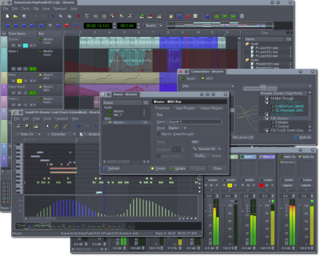A music sequencer is a device or application software that can record, edit, or play back music, by handling note and performance information in several forms, typically CV/Gate, MIDI, or Open Sound Control, and possibly audio and automation data for digital audio workstations (DAWs) and plug-ins.

Ardour is a hard disk recorder and digital audio workstation application that runs on Linux, macOS, FreeBSD and Microsoft Windows. Its primary author is Paul Davis, who was also responsible for the JACK Audio Connection Kit. It is intended as a digital audio workstation suitable for professional use.

Multitrack recording (MTR), also known as multitracking, is a method of sound recording developed in 1955 that allows for the separate recording of multiple sound sources or of sound sources recorded at different times to create a cohesive whole. Multitracking became possible in the mid-1950s when the idea of simultaneously recording different audio channels to separate discrete "tracks" on the same reel-to-reel tape was developed. A "track" was simply a different channel recorded to its own discrete area on the tape whereby their relative sequence of recorded events would be preserved, and playback would be simultaneous or synchronized.

Cubase is a digital audio workstation (DAW) developed by Steinberg for music and MIDI recording, arranging and editing. The first version, which was originally only a MIDI sequencer and ran on the Atari ST computer, was released in 1989. Cut-down versions of Cubase are included with almost all Yamaha audio and MIDI hardware, as well as hardware from other manufacturers. These versions can be upgraded to a more advanced version at a discount.

Virtual Studio Technology (VST) is an audio plug-in software interface that integrates software synthesizers and effects units into digital audio workstations. VST and similar technologies use digital signal processing to simulate traditional recording studio hardware in software. Thousands of plugins exist, both commercial and freeware, and many audio applications support VST under license from its creator, Steinberg.

Pro Tools is a digital audio workstation (DAW) developed and released by Avid Technology for Microsoft Windows and macOS. It is used for music creation and production, sound for picture and, more generally, sound recording, editing, and mastering processes.

A digital audio workstation is an electronic device or application software used for recording, editing and producing audio files. DAWs come in a wide variety of configurations from a single software program on a laptop, to an integrated stand-alone unit, all the way to a highly complex configuration of numerous components controlled by a central computer. Regardless of configuration, modern DAWs have a central interface that allows the user to alter and mix multiple recordings and tracks into a final produced piece.

Logic Pro is a proprietary digital audio workstation (DAW) and MIDI sequencer software application for the macOS platform developed by Apple Inc. It was originally created in the early 1990s as Notator Logic, or Logic, by German software developer C-Lab which later went by Emagic. Apple acquired Emagic in 2002 and renamed Logic to Logic Pro. It was the second most popular DAW – after Ableton Live – according to a survey conducted in 2015.
Waveform is a digital audio workstation for recording and editing audio and MIDI. The software is cross-platform, that runs on Apple macOS, Microsoft Windows, and Linux.

REAPER is a digital audio workstation and MIDI sequencer application created by Cockos. The current version is available for Microsoft Windows and macOS, as well as for Linux. REAPER acts as a host to most industry-standard plug-in formats and can import all commonly used media formats, including video. REAPER and its included plug-ins are available in 32-bit and 64-bit format.
n-Track Studio by n-Track Software is a multitrack audio editing, digital audio workstation (DAW) program for Microsoft Windows, OS X, Android and iOS.

BIAS was a privately held corporation based in Petaluma, California. It ceased all business operations as of June, 2012.
In computer music and professional audio creation, a DirectX plugin is a software processing component that can be loaded as a plugin into host applications to allow real-time processing, audio effects, mixing audio or act as virtual synthesizers. DirectX plugins allow the replacement of traditional recording studio hardware and rack units used in professional studios with software-based counterparts that can be connected together in a modular way. This allows host manufacturers to focus on the conviviality and efficiency of their products while specialized manufacturers can focus on the digital signal processing aspect. For example, there are plugins for effects boxes, such as reverbs and delays, effects pedals, like guitar distortion, flange and chorus, and for mixing and mastering processors such as compressors, limiters, exciters, sub bass enhancers, stereo imagers and many more.

Logic Studio is a discontinued professional music production suite by Apple Inc. The first version of Logic Studio was unveiled on September 12, 2007. It claims to be the largest collection of modeled instruments, sampler instruments, effect plug-ins, and audio loops ever put in a single application.

Qtractor is a hard disk recorder and digital audio workstation application for Linux. Qtractor is written in C++ and is based on the Qt framework. Its author is Rui Nuno Capela, who is also responsible for the Qjackctl, Qsynth and Qsampler line of Linux audio software. Qtractor's intention was to provide digital audio workstation software simple enough for the average home user, and yet powerful enough for the professional user.
In music recording, mix automation allows the mixing console to remember the audio engineer's adjustment of faders during the post-production editing process. A timecode is necessary for the synchronization of automation. Modern mixing consoles and digital audio workstations use comprehensive mix automation.
Magix Music Maker is a commercial digital audio workstation (DAW) designed by the company Magix for the consumer sector. The program is branched from Samplitude, Magix's professional digital audio workstation. Music Maker was first published in 1994. By 2006 it had sold over a million copies in varying versions
MAGIX Samplitude/ Sequoia is a computer program made by MAGIX for recording, editing, mixing, mastering and outputting audio. The first version was released in 1992 for the Amiga and three years later for Microsoft Windows. The latest versions of the software are Samplitude Pro X5, Samplitude Pro X5 Suite and Sequoia 16. Samplitude is an example of a digital audio workstation (DAW).

A bedroom producer is an amateur musician who creates, performs, and records their music independently using a home studio, often considered a hobbyist opposed to a professional record producer in the recording industry that works in a traditional studio with clients. Typically bedroom producers use accessible digital technology that costs less than the equipment in a professional studio, such as MIDI controller-based instruments and virtual studio technology, to create music for release to the world. While a professional record producer oversees and guides the recording process, often working alongside multiple people such as studio musicians, singers, engineers, mixers, songwriters, arrangers, and orchestrators, a bedroom producer does everything independently: creating the ideas, recording them and processing them for release. Bedroom producers are often self-taught, learning sound design, mixing and music theory by reading music production blogs and watching tutorials on the internet. As bedroom producers depend on the accessibility of music technology, bedroom production has been made easier with advances in home computing power and digital audio workstations (DAW).










